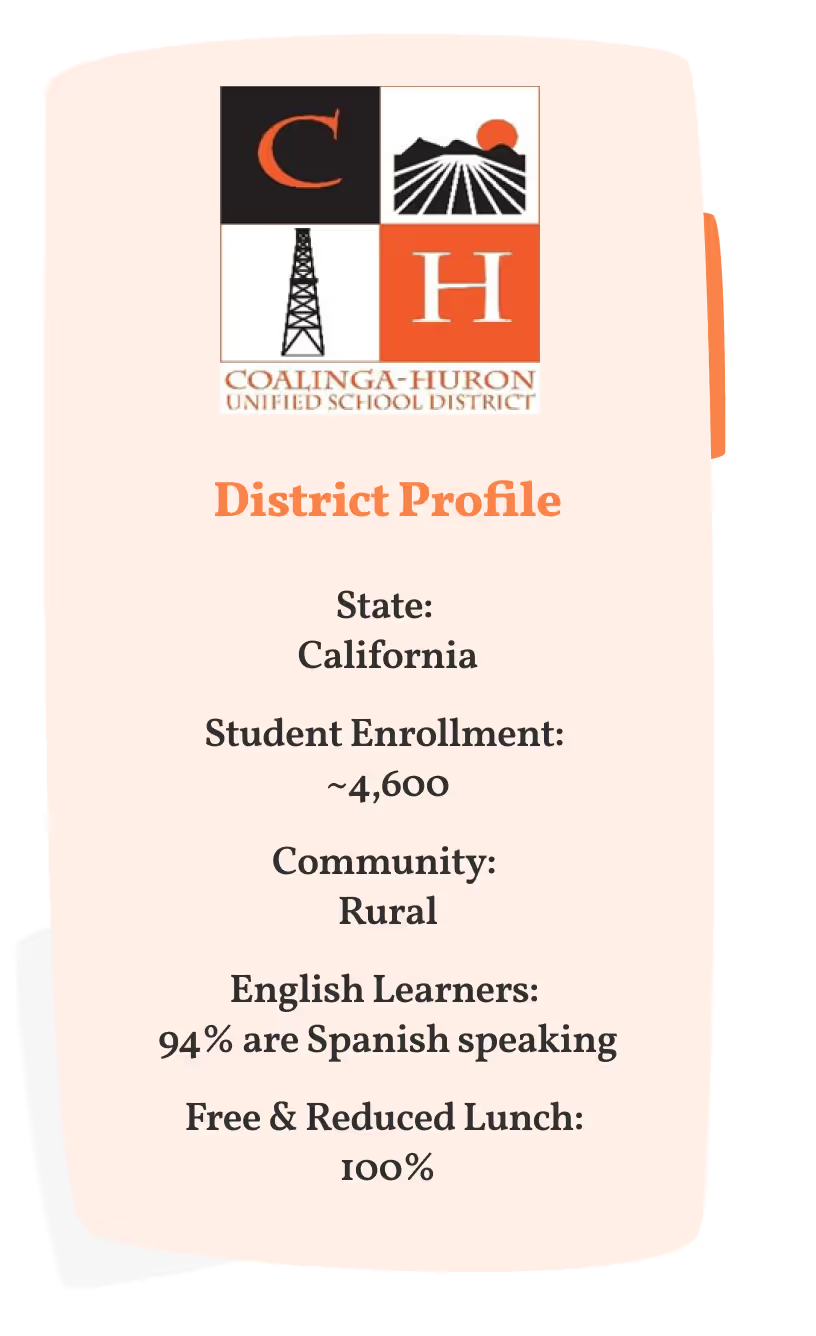Coalinga-Huron Unified School District

The Challenge
Since the pandemic, students at Coalinga-Huron Unified School District (CHUSD) have been experiencing an increase in anxiety, depression, and anger dysregulation. As is often the case, the administration sees the impact of this in rising rates of chronic absenteeism, decreasing test scores, and an increase in behavioral issues.
The Opportunity
The school-based mental health team at Coalinga-Huron has responded to these increased needs by creating the new structures and systems of support to ensure that every student has access to the mental health support they need and opportunities to develop the coping skills they can use to thrive in school and in life.
1. Developing partnerships with families
The team knows that in order for students to be successful, it’s important to develop strong partnerships with families. “If we’re not building it with them, we’re not building it for them,” says Jonathan Spreng, Administrator on Special Assignment in CHUSD’s School-Based Mental Health & Wellness Department. The team works hard to communicate regularly with families so that the skills kids are learning to support their unique mental health needs are practiced and reinforced at home.
2. Systemizing and operationalizing the process
All of the school counselors in the district are trained to implement multi-tiered interventions for all students. This enables them to easily refer a student who needs support that is above and beyond their scope while two district level LMFT’s triage the needs to ensure the student gets the appropriate support. If there’s an immediate need, the District LMFT’s support these students until they are connected to the appropriate resources.
Every month, each school site has a care coordination team meeting to discuss potential and current cases. A county partner is also in attendance to ensure there’s a wrap-around perspective so they can support the child in the best way possible. The necessary information is then reported back to the school counselors on-site so they can support specific students on campus as well.
3. Staffing and creating the space
The mental health team knew that they needed some additional resources to ensure that students had a safe, confidential, and convenient space to meet with their mental health providers. The team meets with the administration at the beginning of the school year to understand what space is available at each school site. This might be an unused space that has accumulated old materials or an office that is barely used. After some hard work, they’ve been able to create a wellness space at the high school with two additional spaces opening at the middle schools by the end of the 2023-24 school year. These spaces will be a place where students can engage with outside services or just drop-in for 15-minutes to self-regulate.
In order for these wellness centers to be successful, they hired one Wellness Coordinator at the high school and plan to hire two additional Coordinators for middle schools. This person is responsible for the day-to-day operations, program implementation, coordinating direct services, helping students with drop-in needs, and leading school-wide prevention and education efforts. Check out Coalinga-Huron’s job description for their Wellness Coordinator position below.
4. Partnering with Daybreak
Being a rural district, about 60-70 miles from the nearest metropolitan area, students and families aren’t able to access the necessary services and local community resources have at least a 6 months waiting list for services. The district realized they had a gap in services and the in-school teams were overloaded with cases. They turned to Daybreak to provide teletherapy services and ongoing mental health screeners to monitor youth mental health in an ongoing way.
The Results
“Daybreak is one of the best things we’ve ever done and is our strongest partner in school-based mental health,” said Spreng. “They’re receptive to our needs and have filled a big gap for us. We can now provide services to our students when and where they need it.”
Janine Wagner, one of CHUSD’s School-Based Mental Health Therapists, is responsible for managing the referrals to Daybreak’s services. She says that, “The process with Daybreak is seamless. The referring party stays in the loop on every student’s progress. I appreciate having a partner we can trust and have built a strong relationship with the team.”
Wagner added that, “Having access to Daybreak’s qualified clinicians has freed up the on-site team to focus on more critical needs and situations and really helps to distribute the caseload.”
Spreng appreciates having measurable data to go back to the school board with. It helps to prove how important the investment is when they can see the number of students who are going through the program and improved clinical outcomes.
Wellness Coordinator Job Description
Job Summary
This is a certificated position. Under the direction and supervision of the school principal, the Wellness Center Coordinator is responsible for running the Wellness Center, including: program implementation, day-to-day operations, coordinating direct services, and spearheading school-wide prevention and education efforts. The Wellness Center Coordinator also ensures compliance with laws, codes, and regulations related to student support and wellness services; and performs related work as required to ensure that all programs are in alignment with the outcomes for student success as identified in the District’s LCAP plan.
Requirements / Qualifications
Possession of a Masters of Social Work or School Counseling with a Pupil Personnel Services Credential required, with at least 3 years experience in mental health coordination, outreach, education and case management.

Downloadable Content
The State of Youth Mental Health & Our Schools
How schools are responding to the rising demand for student mental health services.
.svg)
.png)